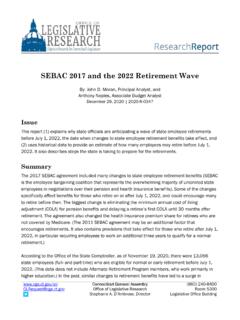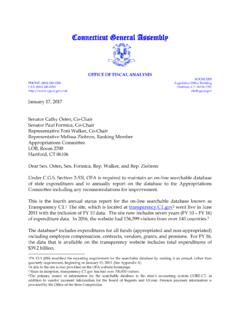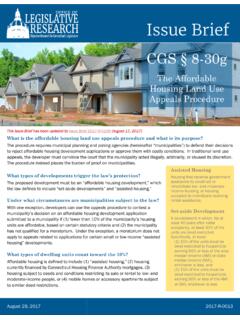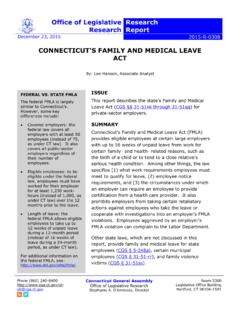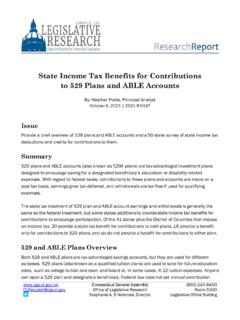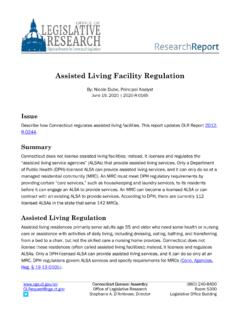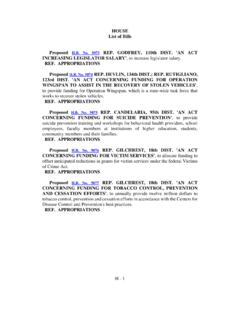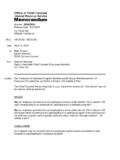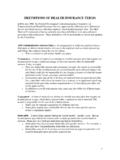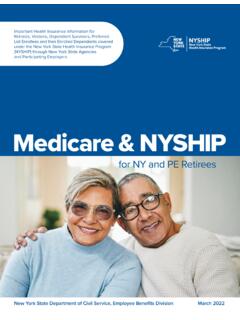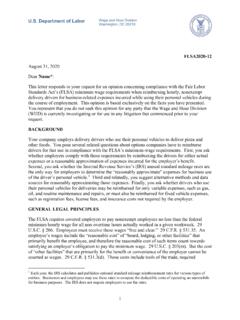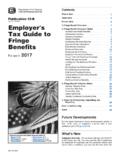Transcription of No Surprises Act
1 No Surprises Act By: Alex Reger, Principal Analyst January 20, 2022 | 2022-R-0012. Issue Briefly summarize the surprise billing provisions of the federal No Surprises Act ( 116-260, Division BB, Title 1), including the state's role in establishing provider reimbursement amounts for these bills. The Office of Legislative Research is not authorized to provide legal opinions and this report should not be considered one. Summary The federal No Surprises Act, established as part of the Consolidated Appropriations Act of 2021, places requirements on health insurers and health care providers that are designed to protect consumers in surprise billing situations.
2 In practice, surprise billing refers to large, unexpected bills charged to individuals by out-of-network providers at in-network facilities. Beginning January 1, 2022, the No Surprises Act prohibits surprise billing for (1) out-of-network emergency services, including air ambulance (but not ground ambulance) services and (2) in-network nonemergency services provided under certain circumstances. The act applies to self- and fully-insured health insurance plans. In these surprise billing situations, the act generally requires health carriers ( , insurers and plan administrators of self-insured plans) to bill patients at the in-network level of service and calculate patient cost-sharing based on in-network rates.
3 By establishing the maximum patient responsibility for emergency and non-emergency surprise bills, the act also prohibits balance billing for these services. ( Balance billing refers to providers billing patients for the difference between a service's cost and the amount the health carrier reimburses the provider for the service.). Connecticut General Assembly (860) 240-8400. Office of Legislative Research Room 5300. Stephanie A. D'Ambrose, Director Legislative Office Building The act also provides a methodology for calculating how much All-Payer Model Agreements insurers pay providers in surprise billing situations.
4 However, this federal methodology does not apply in states that have their own An all-payer model is a type of Medicaid demonstration waiver that allows surprise billing laws or an all-payer model agreement. According to states to establish prices for certain the federal Centers for Medicare and Medicaid Services (CMS), health care services for all Medicaid, Medicare, and commercial payors ( , Connecticut's existing state laws governing provider insurers). Currently, Maryland and reimbursements for these services will apply for purposes of Vermont have such agreements.
5 Determining the out-of-network rate in specified situations (see attached). Additional details of the payment methodology will be clarified when the relevant federal agencies publish the final rule. In addition to these surprise billing provisions, the act imposes several other requirements on health carriers. For example, it includes additional consumer notification requirements and requires carriers to provide insureds with a good faith cost estimate before a service. In addition, it requires carriers to offer price comparison information by phone and develop an online price comparison tool.
6 Among other things, the act also (1) requires insurers to allow a parent to designate a pediatrician as the primary care provider (PCP) for a child if the plan requires a PCP, a nd (2). prohibits insurers from requiring prior authorization or referrals for obstetrical and gynecological care (42 300gg 117(b) & (c)). It also establishes a ground ambulance advisory group to study how ambulance patients are impacted by balance billing and other factors ( 116-260 . 117). As with many other federal insurance laws, the state is responsible for enforcing the law's provisions on fully insured health insurance products, while the federal government is responsible for doing so for self-insured plans ( plans covered under the federal Employee Retirement Income Security Act (ERISA)).
7 Emergency Services Generally, the act requires group health plans ( , employer sponsored plans governed under ERISA) and group and individual health insurance policies that cover emergency services to cover them: 1. without the need for prior authorization;. 2. regardless of whether the provider is in- or out-of-network; and 3. at the in-network level of benefits, including at or below the in-network level of cost-sharing, regardless of other coverage terms and conditions (42 300gg 111(a)). 2022-R-0012 January 20, 2022 Page 2 of 6.
8 This last requirement correspondingly requires health carriers to apply any cost-sharing towards an insured's or enrollee's deductible and out-of-pocket maximum, as if the service was in-network. These provisions also generally apply to services provided by air-ambulance (42 300gg . 112). Cost-Sharing Generally, the act requires insurers to calculate the patient's cost-sharing ( , coinsurance, copay, or deductible) as if the emergency service was provided in-network. For example, if a patient's in- network cost-sharing for the service is a $15 copay, he or she will have the same $15 copay for applicable out-of-network emergency services.
9 Because the act bans balance billing, this cost- sharing amount is the total the patient is required to pay, regardless of the service's cost. In practice, some individual cost-sharing is not a flat fee (like a copay) but is instead based on a service's cost ( , a coinsurance or deductible amount). For these circumstances, and for provider reimbursements described below, the act sets a service's cost based on the insurer's median in- network rate, as adjusted for inflation, determined by the Secretary of Health and Human Services (HHS) (42 300gg 111(a)(3)(E)).
10 For example, if a patient's in-network cost-sharing is 20%, the patient will owe 20% of the median in-network cost for emergency surprise bills, up to the in- network out-of-pocket maximum and deductible. If a state has already established a service's cost through either an all-payer model or a specified state law (see below), this established cost is considered the cost under the No Surprises Act. As a result, the cost would not be determined by the median in-network provision described above (42. 300gg 111(a)(3)(H)).
